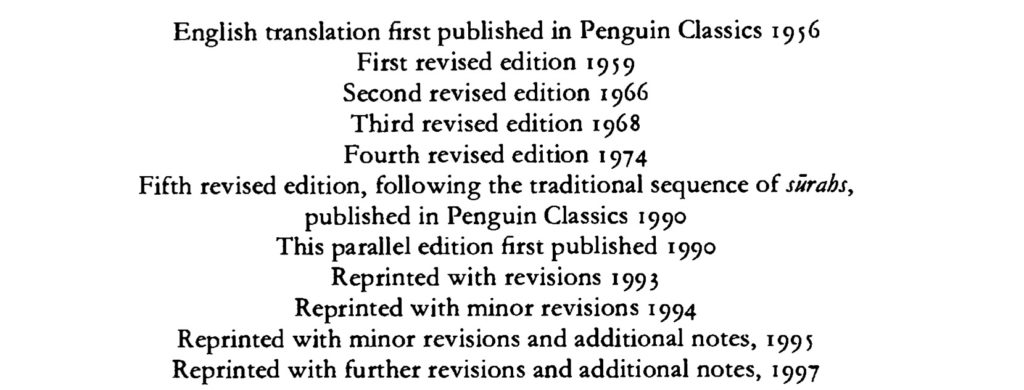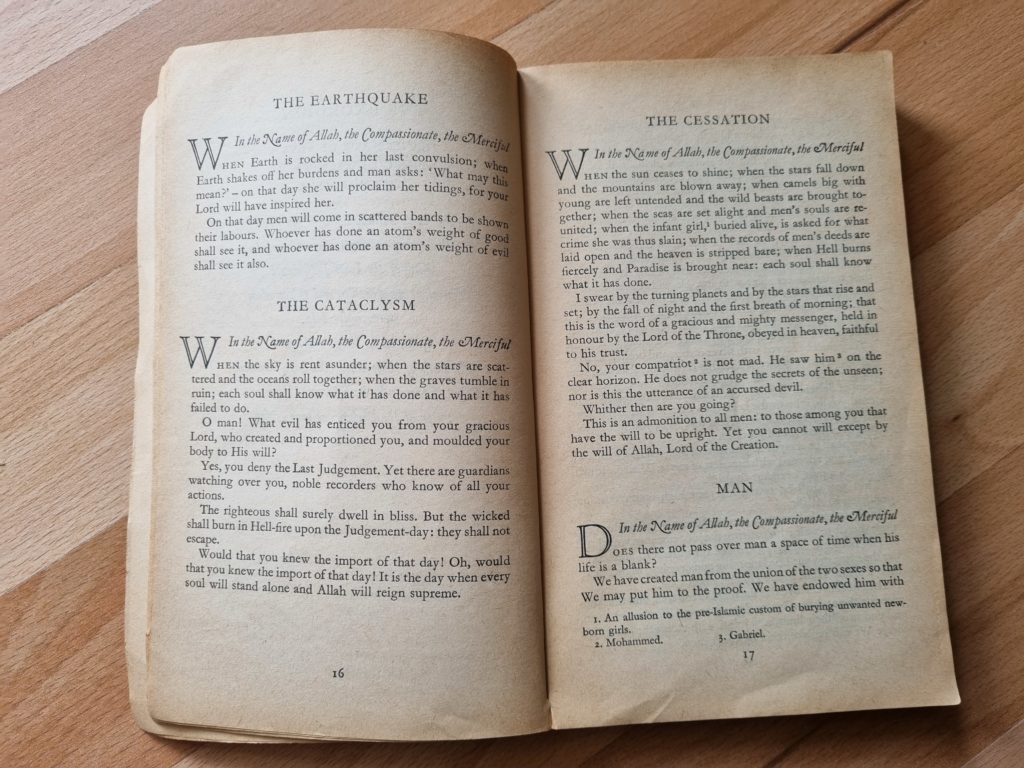In 1956, Penguin Classics published The Koran by N. J. Dawood (1927–2014), an Iraqi Jew. It stood out by dint of being the very first Qur’an translation into contemporary English, a fact which means it has had a big impact on many later Muslim and non-Muslim translators, whether or not they approved of Dawood’s endeavour.
Born to a family of Jewish merchants who were fluent in Arabic and French and knew some English, Dawood received a scholarship to study in England, where he arrived in 1945. Dawood’s original name was actually Nessim Yehudi, but his Iraqi passport carried his father’s and his grandfather’s names, Yousef/Joseph and Dawood/David, and Dawood became his official last name when he was granted British citizenship. He started working for Penguin Classics in around 1950, translating a collection of stories from the ‘Thousand and One Nights’ that was first published in 1954. In his translation, Dawood abandoned the original text’s division of the stories into separate nights and rearranged them along the lines of a European collection of fairy tales, to fit them into the mould of ‘world classics’ in a way that would not alienate European readers.
His approach to the Qur’an was similarly unafraid of interfering with the text. His aim was ‘to present the modern reader with an intelligible version of the Koran in contemporary English’ in an arrangement that would not put them off. ‘It is unfortunate,’ he wrote, ‘that in preparing the contents of the Koran for book-form its editor or editors followed no chronological sequence. […] the uninitiated reader, […] understandably, is often put off by such mundane chapters as “The Cow” or “Women”, with which the traditional arrangement of the Koran begins.’ He felt that the canonical arrangement was incoherent and, since it was not based on the authority of Muḥammad, that there was no reason to uphold it. Therefore, he abandoned it completely. But, unlike some previous translators, he did not instead follow a chronological arrangement, because he believed that this would have required him to split up some suras. Rather, he arranged the suras according to his stylistic preferences, with the ‘more poetical revelations’ first, and the longer and ‘often more topical’ chapters last. He opened with the Fātiḥa (Q 1), which he entitled rather pompously as ‘The Exordium,’ and followed it up with three suras that start with apocalyptic oaths and imagery (Q 99, 82, 81).
The aim was to present the Qur’an not so much as scripture but as ‘world literature’ to non-Muslim readers, and he clearly felt that certain elements of the text, such as verse numbers or easily recognisable sura titles, were not a requirement for that target group. Given the massive increase in the Muslim population of Britain in the second half of the twentieth century, this eventually became a problem. Ziauddin Sardar blasted Dawood’s translation in his 2008 Guardian review of its successor in the Penguin Classics series, Tarif Khalidi’s The Qur’an. According to Sardar, Dawood’s translation ‘has been a great source of discomfort for Muslims, who see in it deliberate distortions that give the Qur’an violent and sexist overtones.’ Comparing Dawood, a non-Muslim translator, with Khalidi, a Muslim, Sardar points to the differences in title (Koran versus Qur’an), which he says signal a shift from Orientalist representations of the Qur’an to a more inclusive attitude that is sensitive to Muslim approaches to the text. He also points to differences in the sura names provided in the two translations, for example Dawood’s cumbersome ‘Exordium’ versus Khalidi’s ‘The Opening’, or Dawood’s translation of the sura name al-Zumar (Q 39) as ‘The Hordes’ which, Sardar says, suggests barbarism, whereas Khalidi has ‘The Groups.’ Finally, Sardar accuses Dawood’s translation of presenting the Qur’an ‘as a patriarchal, sexist text’:
A good example is provided by 2:21. In Dawood we read: ‘Men, serve your Lord.’ In Khalidi, it becomes: ‘O People! Worship your Lord.’ Dawood’s translation of the famous verse 2:25, frequently quoted, is largely responsible for the current misconception that Muslim paradise is full of ‘virgins’ – despite the fact that the Qur’an explicitly denies any carnal pleasures in paradise. This is because we find ‘men’ in Dawood’s translation in the garden of paradise who are ‘wedded to chaste virgins’. Khalidi renders it correctly: ‘In these gardens they have immaculate spouses.’
This criticism was justified, in a way, because Dawood’s gendered translation of terms such as nās (‘people’) and azwāj (‘spouses,’ ‘mates’) were far more similar to those used by British Orientalists such as Sale, Rodwell and Palmer than to those used by previous Muslim translators such as Pickthall, Yusuf Ali and Daryabadi, who had preferred less gendered terminology.
However, Sardar’s criticism was based on the earliest editions of Dawood’s translation and much of it had been addressed in subsequent revisions by Dawood himself, who kept making changes throughout his life until the publication of the very last edition of his translation in 2014. One major modification occurred in 1990 when he rearranged the suras to follow the canonical order and Penguin started printing a bilingual Arabic-English edition in an obvious attempt to attract Muslim readers. Interestingly, in a somewhat counterintuitive move, Dawood simultaneously changed the translation of allāh from ‘Allah’ to ‘God’. By 1990, the sura title ‘The Hordes,’ so criticized by Sardar, had been changed to ‘The Throngs’, ‘men’ had become ‘people’ and the ‘virgins’ had become ‘spouses.’
Dawood’s revisions were extensive and many segments were revised more than once. For example, the description of God as mālik yawm al-dīn in Q 1:4 changed first from ‘King of the Last Judgement’ (1956) to ‘King of Judgement Day’ (1974) and then to ‘Sovereign of the Day of Judgement’ (1990). The editions also came with an ever-increasing number of notes that were partly based on the Qur’anic commentaries by Zamakhsharī, Bayḍāwī and the Jalālayn.
What Sardar did not acknowledge, and probably failed to even recognise, was the distinctive character of Dawood’s decision to use modern English, which made his translation a lasting achievement. Seen from today’s perspective, this might not appear particularly remarkable. However, before Dawood’s The Koran was first published, there had not been a single translator of the Qur’an into English who wrote in modern English. Instead, they unanimously opted for the archaic ‘King James style’ which was based on the language of the sixteenth-century King James Bible and the idiom of Shakespeare that translators from Scotland to British India had been raised to revere. In that idiom, the use of ‘thou’ and ‘thee,’ ‘verily’ and ‘Lo!,’ abounded and the style was often somewhere between pompous and cumbersome.
To give a few examples that illustrate the differences between King James style translations and Dawood’s The Koran:
Rodwell (1861) rendered Q 1:5 (iyyāka naʿbudu wa-iyyāka nastaʿīn) as ‘Thee only do we worship, and to Thee do we cry for help.’ Dawood rendered the same verse as ‘You alone we worship, and to You alone we pray for help.’
Muhammad Ali (1917) translated the expression ṣirāṭ alladhīna anʿamta ʿalayhim (Q 1:7) as ‘The path of Those upon whom Thou hast bestowed favours’ whereas Dawood simply wrote: ‘The path of those whom You have favoured’.
Pickthall (1930) rendered the phrase innaka ʿalā kulli shayʾin qadīr (Q 66:8) as ‘Lo! Thou art able to do all things’; Dawood wrote ‘You have power over all things.’
Palmer (1880) translated the phrase wa-ilayka l-maṣīr (Q 60:4) as ‘and unto thee the journey is’ whereas Dawood preferred the much more idiomatic line ‘and to you we shall come at last.’
Dawood was not only critical of previous translators because of the archaic style they used. He commented in his introduction that: ‘In adhering to a rigidly literal rendering of Arabic idioms, previous translations have, in my opinion, completely failed to convey both the meaning and the rhetorical grandeur of the original.’ That this assessment is not entirely off the mark can be seen when we compare his take on Q 99:1:
إِذَا زُلْزِلَتِ الْأَرْضُ زِلْزَالَهَا
to that of previous translators.
In their desire to stay as close to the source text as possible, some of them produced gems such as
‘When the Earth with her quaking shall quake’ (Rodwell), or
‘When the earth is shaken by her full shaking’ (Daryabadi, 1950s).
Dawood, conversely, was more interested in producing a text that read fluently, without the Arabic syntax and insertions in brackets that most previous translators had favoured. He accordingly rendered the first segment of Q 99 as follows:
‘When Earth is rocked in her last convulsion; when Earth shakes off her burdens and man asks: ‘What may this mean?’ – on that day she will proclaim her tidings, for your Lord will have inspired her.’
Whatever the exegetical problems with his approach might have been, he was undoubtedly more successful than previous translators at giving readers at least an approximate impression of the imagery and rhythm of the source text.
From the 1970s onward, an increasing number of translators, including Taqi al-Din al-Hilali and Muhammad Muhsin Khan (probably the first Muslims among them), followed Dawood’s choice to use modern English without archaisms. Today, many successful and widely available Qur’an translations shun the King James style, including those by Saheeh International, M.A.S. Abdel Haleem, Muhammad Taqi Usmani, Ali Quli Qara’i, Aisha Bewley, and various Qur’anists. While not all of Dawood’s choices gained the approval of Muslim readers, he fundamentally expanded the stylistic repertoire available to Qur’an translators in English.
Johanna Pink









